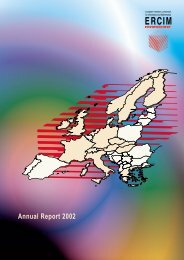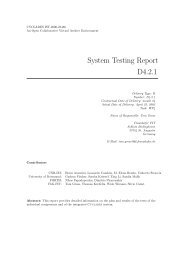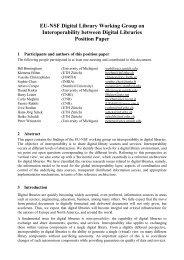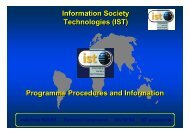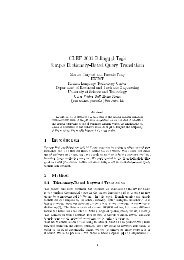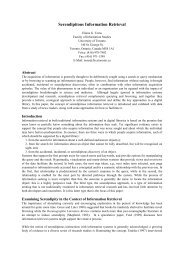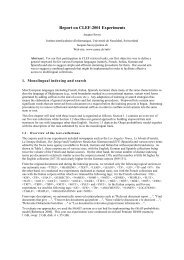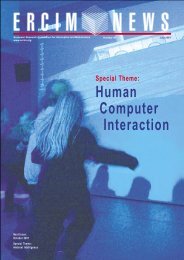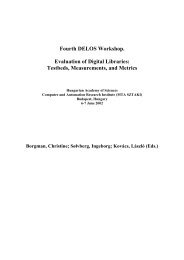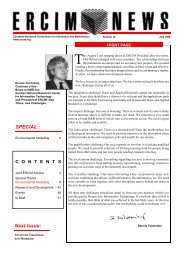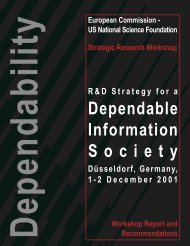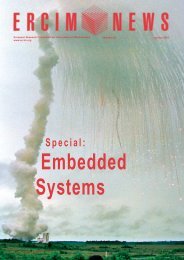Towards a Platform for Widespread Embedded Intelligence - ERCIM
Towards a Platform for Widespread Embedded Intelligence - ERCIM
Towards a Platform for Widespread Embedded Intelligence - ERCIM
You also want an ePaper? Increase the reach of your titles
YUMPU automatically turns print PDFs into web optimized ePapers that Google loves.
study. However, one result of the TNO<br />
study was a temporary and partial moratorium<br />
on the construction of new base<br />
stations in Switzerland, pending a more<br />
thorough study.<br />
A Swiss scientific consortium was<br />
<strong>for</strong>med to carry out such a more thorough<br />
study. It was per<strong>for</strong>med by a group<br />
of scientists from the University of<br />
Zurich, the University of Bern, and from<br />
the Swiss Federal Institute of<br />
Technology in Zurich. Several methodological<br />
improvements were implemented,<br />
including investigating a larger<br />
sample size and applying two different<br />
UMTS exposure levels, all yielding<br />
more robust results. The results were<br />
published on June 6, 2006. [4]<br />
The effect of UMTS radiation found in<br />
the TNO study was not confirmed in the<br />
new Swiss study. It should be noted that<br />
the experiment had to do only with 45-<br />
minute UMTS-radiation exposure intervals<br />
(four of them separated by a period<br />
of one week) and radiation absorption in<br />
brain tissue was considerably smaller<br />
than during the use of a mobile phone.<br />
Thus, the authors concluded, "No conclusions<br />
can be drawn regarding shortterm<br />
effects of cell phone exposure or<br />
the effects of long-term, base-stationlike<br />
exposure on human health."[4]<br />
Nevertheless, several of the temporary<br />
and partial moratoria <strong>for</strong> the construction<br />
of new UMTS base stations in<br />
Switzerland were withdrawn, even<br />
though the question of long-term effects<br />
of UMTS radiation on humans remains<br />
open.<br />
Meanwhile, the REFLEX study under<br />
Professor F. Adlkofer, was making measurements<br />
on isolated cells to see if these<br />
were effected by a high or low-frequency<br />
(power-line frequency) EMF (electromagnetic<br />
field). Quoting from the report:<br />
References<br />
[1] Seitz H., Stinner D., Eikmann T., Herr C., Röösli M.; Electromagnetic<br />
Hypersensitivity (EHS) and Subjective Health Complaints Associated with<br />
Electromagnetic Fields of Mobile Phone Communication: A literature review [of<br />
papers] published between 2000 and 2004.<br />
Science of the Total Environment, 2005; 349 (1-3): 45-55.<br />
[2] Altpeter, E.-S, Martin Röösli, M., Battaglia, M., Pfluger, D., Minder, C. and Abelin, T.;<br />
Effect of Short-Wave (6-22 MHz) Magnetic Fields on Sleep Quality and Melatonin<br />
Cycle in Humans: The Schwarzenburg Shut-Down Study, Bioelectromagnetics,<br />
Vo. 27, pp 142-150, 2006.<br />
[3] Zwamborn, A.P.M., Vossen, S.H.J.A., van Leersum, B.J.A.M., Ouwens, M.A.,<br />
Makel, W.N.; Effects of Global Communication System Radio-Frequency Fields on<br />
Well Being and Cognitive Functions of Human Subjects with and without Subjective<br />
Complaints. Netherlands Organization <strong>for</strong> Applied Scientific Research (TNO).<br />
FEL-03-C148, 2003.<br />
[4] Regel S.J., Negovetic S., Röösli M., Berdiñas V., Schuderer J., Huss A., Lott U.,<br />
Kuster N., Achermann P. ; UMTS Base Station Like Exposure, Well Being and<br />
Cognitive Per<strong>for</strong>mance. Environmental Health Perspectives 2006, 114 (8): 1270-1275<br />
(http://www.ehponline.org/members/2006/8934/8934.html)<br />
[5] Winker, R, Ivancsits, S., Pilger, A., Adlkofer, F. and Rudiger, H. W.<br />
Chromosomal Damage in Human Diploid Fibroblasts by Intermittent Exposure to<br />
Extremely Low-Frequency Electromagnetic Fields, Mutation Research, Vol. 585,<br />
Issues 1-2, pp. 43-49, 1 August 2005, http://www.verum-foundation.de/cgibin/content.cgi?id=euprojekte01<br />
[6] Diem E., Schwarz C., Adlkofer F., Jahn O., Rüdiger H.; Non-Thermal DNA<br />
Breakage by Mobile Phone Radiation (1800 MHz) in Human Fibroblasts and in<br />
Trans<strong>for</strong>med GFSH-R17 Rat Granulosa Cells in Bitro. Mutation Research, Vol. 583,<br />
(2), pp. 178-183, 2005.<br />
R&D AND TECHNOLOGY TRANSFER<br />
"The main goal of the REFLEX project<br />
was to investigate the effects of EMF on<br />
single cells in vitro at the molecular level<br />
below the energy density reflected by the<br />
present safety levels."[5] The study<br />
showed that in certain human cell types<br />
there was indeed a significant increase in<br />
the number of single- and double-strand<br />
breaks in the DNA as a result of high [6]<br />
and extremely low-frequency electromagnetic<br />
fields [5].<br />
These results fascinated Professor Primo<br />
Schaer at the Center <strong>for</strong> Biomedicine at<br />
the University of Basel. In a talk at a<br />
meeting on June 29 of this year, organized<br />
by the Swiss Research Foundation<br />
<strong>for</strong> Mobile Communication, Professor<br />
Schaer gave a preliminary report on his<br />
own experiments which confirm the<br />
work in Vienna, showing that intermittent<br />
extremely low frequency fields can<br />
result in damage to DNA. At this point in<br />
time these research results are unpublished;<br />
but, when published, we will<br />
report on them here in <strong>ERCIM</strong> News.<br />
Professor Schaer emphasized that some<br />
DNA damages are repaired by the DNA<br />
repair mechanism. Thus, the observed<br />
genotoxic effects do not necessarily<br />
mean that EMF is carcinogenic <strong>for</strong> the<br />
human.<br />
In conclusion, we now know that EMF<br />
does have some effects on humans and<br />
human cells. Since we still do not know<br />
what the effect is on our health and wellbeing,<br />
some degree of caution would<br />
seem to be called <strong>for</strong>.<br />
Links:<br />
TNO follow up study: http://www.mobileresearch.ethz.ch/projekte.htm#18<br />
EMF projects at the University of Bern:<br />
http://www.ispm.ch/index.php?id=814<br />
Primos research group at the University of<br />
Basel:<br />
http://pages.unibas.ch/dbmw/biochemie/<br />
Please contact:<br />
Martin Röösli, University of Bern,<br />
Switzerland<br />
E-mail: roeoesli@ispm.unibe.ch<br />
Harry Rudin, Consultant, Switzerland<br />
E-mail: hrudin@smile.ch<br />
<strong>ERCIM</strong> News No. 67, October 2006<br />
59



